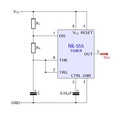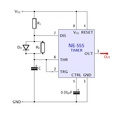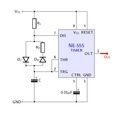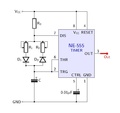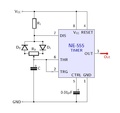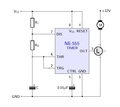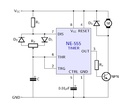Generate pwm using ic 555
Introduction
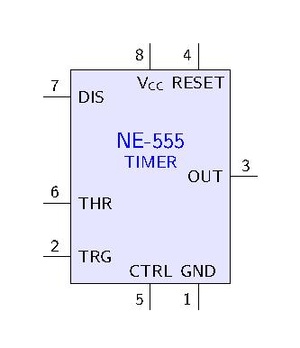
IC 555 is an astable multivibrator (oscillator).
Frequency: The ON time is defined by the time taken to its capacitor to charge to 2/3 (1/e??) level through pin7 resistor, and the OFF time is the discharging time of the capacitor through pin7, 1/3. See the precise numbers from [1].
Monostable state. Bistable state. [2]
Theory
The resistance is much smaller than the resistance of the potentiometer, for example, 1K compared to 100K of the potentiometer. In that way we have 99% control over the charging and discharging resistance in the circuit. See https://electronics.stackexchange.com/questions/175967/how-do-i-use-pin5-to-control-duty-cycle-of-a-555-based-pwm
The output of the 555 timer can source a current of 200mA to the load.
- Use MOSFET (eg TIP122 Darlington transistor; 5A) for driving the motor.
To obtain a zero percent (0%) duty cycle, the oscillator need to stop oscillating. One option is to use a parallel resistor to use some of the current.
Method 1; the simple
-
The simple 555 circuit.
-
The differences in C and output. Note that more than 50% pwm is not obtained
-
The surface and contour plot of the limits of the R1 and R2 values.
See the details from Generate pwm using ic 555: The simple method
Method 2; Longer low time: Add a Diode
-
The schematics.
-
The simulations.
-
The contour and surface plot of varying resistances.
-
Added the second diode. This will make the output identical if R1 and R2 are identical.
-
One more resistance (or potentiometer) to make it more symmetric. This is discussed in more detailed in the next chapter, because the two potentiometers can be easily replaced by a one.
See the details from Generate pwm using ic 555: Add a diode.
Method 3; Back to two resistors
-
The diodes
The two variable resistors R1 and R2 can be replaced by only one potentiometer, now named R1. The charge and discharge timing of the capacitor is bifurcated through separate channels via the diodes.
See [4] for more text. This might be a good: [5].
PWM: Add a transistor to more powerful applications
-
Added a transistor to the simplest method.
-
More detailed version. Use two diodes for charging the capacitor and one to prevent EMF current from the motor. Also a resistor is added to reduce base voltage to the npn.
The 555 can source or sink (supply or pass to ground) around 200mA, thus to drive larger currents we need an output circuit. The 555 will work from 5 to 15 volts, thus a same voltage source can be used. FOr controlling the motor we use TIP31 NPN transistor (max 3A).
Parts
- 1N4148 x 3; third diode is used in parallel with the motor to suppress the voltage transients as the motor switches ON and OFF.
- R_o: 1k limits the current flow into the base of the transistor
- R: 10k
- Potentiometer: 100k
- 0.1 uF
- 100 nF
- TIP31 NPN Transistor/ BD220 (rated 70V, 4 amps) + heatsink
- 12V Motor or a dimmable load
https://diyodemag.com/education/fundamentals_versatile_555_timer_pwm_control
- But more diodes
Or a MOSFET
Mosfet allows more current (they operate on a totally different electrical principle).
- BJT operation is based on current control. Less efficient (higher power dissipation). Lower input impedance. Superior linearity.
- Mosfet operation is based on voltage control. More efficient. Higher switching speed. Better thermal stability. High input impedance.
Method 2: More Diodes
The diodes are used for direction control and protection of the circuit.
555 internal design and theory
See https://www.electronicshub.org/555-timer-pwm/
and the internal circuit looks like below:
Simulation
Simulation is done using https://www.falstad.com/circuit/circuitjs.html simulation software. The corresponding editable circuit file is downloadable.
References
https://www.homemade-circuits.com/how-to-use-ic-555-for-generating-pwm/
https://www.electronicshub.org/555-timer-pwm/
- ↑ https://electronics.stackexchange.com/questions/454406/what-do-0-693-and-1-1-and-1-44-mean-in-ic-555-calculations/454443#454443
- ↑ https://www.build-electronic-circuits.com/555-timer/
- ↑ https://electronics.stackexchange.com/questions/175967/how-do-i-use-pin5-to-control-duty-cycle-of-a-555-based-pwm
- ↑ https://www.homemade-circuits.com/timer-ic-555-explained/
- ↑ https://www.electronics-tutorials.ws/waveforms/555-circuits-part-1.html
- ↑ https://diyodemag.com/education/fundamentals_versatile_555_timer_pwm_control
- ↑ https://how2electronics.com/pwm-based-dc-motor-speed-control-using-555-timer/


